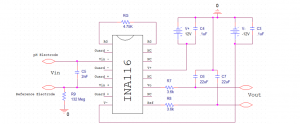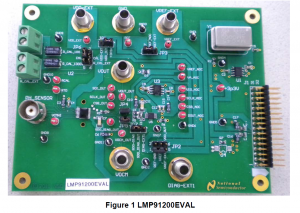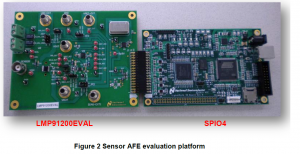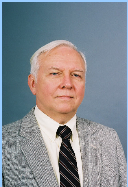During our lab testing with pH and reference electrodes provided by Dr. Hintz, we found the reference electrode to be very sensitive to any movement around it even though the electrodes were enclosed inside a Faraday box . Thus, causing output signal to shift up/down. Per our group conversation with Mr. Marc Hebert at Microelectrodes, he recommended to place a MOhms resistor from the reference electrode to ground for the input bias current to have return path to ground. The figure below shows our contemporary amplifier circuit with the addition of 132 MOhms of resistance.
After placing a MOhm resistor we noticed that even though our output reading were linear for pH (4, 7 & 10) buffer fluids, the output of pH 4 was ( – 1.80 Volts), pH 10 was (- 5.0 Volts) and pH 7 was was (- 3.44 Volts). We are not sure why the output reading changed after placing a MOhms resistor connected from reference electrode to ground.
ASTEC AA16130 power supply provided by Dr. Hintz for our senior design project is being used to power up Dr. Hintz’s alkalinity measurement protoytpe and also our INA116 amplifier. During our lab testing we found out that the (-12 V) outputted by the power supply had a AC ripple as to clean DC signal. In order to get rid of the AC ripple, we installed 2200uF electrolytic capacitor on the (-12 V) of the power supple and got rid of the AC ripple. On the positive 12 volts we saw clean DC signal on the oscilloscope.
In this lab testing, we connected pH and reference electrodes provided by Dr. Hintz to INA116 amplifier. The amplifier was powered with 12 V DC batteries. During our testing we experienced more stability in the output using batteries as oppose to AC to DC power supply. The output of INA116 was connected to an oscilloscope and ADC ( provided by Dr. Hintz). Through ADC we were able to read output as displayed on the GUI.
Modification to amplifier circuit: Please refer to Menu TAB (Issues/Fixes) for more information.
1. pH 4 buffer fluid test
2. pH 7 buffer fluid test
3. pH 10 buffer fluid test
In this lab testing, we connected pH and reference electrodes provided by Dr. Hintz to INA116 amplifier. The amplifier was powered with AC to DC power supply provided by Dr. Hintz. The output of INA116 was connected to an oscilloscope.
1. pH 4 buffer fluid test
2. pH 7 buffer fluid test
3. pH 10 buffer fluid test
The purpose of this project is to improve upon a device that automatically measures pH in order to calculate the alkalinity of seawater using the patented method of reverse gran titration by Dr. Kenneth Hintz and Dr. Christopher Hintz. The current device (Figure 1) which has been designed and implemented by Dr. K. Hintz, obtains an inaccurate reading from the pH electrodes. The task of improvement consists of obtaining an accurate reading of pH with a ±0.02 error margin. The final stage of our project will be incorporated into the current device prototype as shown in figure 1.

Erick Chacon was born and raised in Lima, Peru. His parents moved to the United States when he was 13 years old. As any other immigrant, the first big challenge in his life was to accommodate to a new language and culture. Once he defeated this obstacle, he began to seek what he wanted to do with his life after high school. Through research and some advising from family members and friends, he decided to major in Electrical Engineering. Erick started at the Northern Community College of Virginia (NOVA) and transferred to George Mason University in the Spring of 2011. Through his coursework, he found himself a strong interest in embedded systems, where he is waiting to land a job on. He is currently at his last semester and is expecting to graduate by the end of the year 2014. To see Erick’s profile, clink the following link: https://www.linkedin.com/pub/erick-chacon/72/58/390
LMP91200 Configurable AFE for Low-Power Chemical Sensing Applications. LMP91200 is designed for 2-electrode sensors. Thanks to Texas Instruments for donating the boards for our senior design project.
 Akash graduated from Falls Church High School on June 18th, 2010. He began his studies at George Mason University in the fall of 2010, starting as a computer engineering major. Akash later switched his major to electrical engineering in the fall of 2011. His particular interests in the field are control systems and electronics. He plans to graduate in the spring of 2015.
Akash graduated from Falls Church High School on June 18th, 2010. He began his studies at George Mason University in the fall of 2010, starting as a computer engineering major. Akash later switched his major to electrical engineering in the fall of 2011. His particular interests in the field are control systems and electronics. He plans to graduate in the spring of 2015.
I got my A.S. degree in Automotive Technology (T-TEN) in 2006. Worked at Toyota Dealership for 6 years as a Toyota Master Technician. Due to my interest in Hybrid Technology I decided to pursue B.S. degree in Electrical Engineering at George Mason University. As an Intern, I worked with construction company (General Contractor) as an assistant electrical engineer. During my internship, I worked on many projects including three GMU projects. After graduation I plan to work in Power sector as an Electrical Engineer or Automotive sector as an Automotive Engineer. In future I plan to get my M.S. degree in Automotive Engineering from Clemson University.
Kenneth J. Hintz received his B.S. degree in Electrical Engineering from Purdue University, West Lafayette, Indiana in 1967 and his M.S. and Ph.D. degrees in Electrical Engineering from the University of Virginia in 1979 and 1981 respectively. Since 1987 he has been an Associate Professor in the Department of Electrical and Computer Engineering at George Mason University. He designed and established the Bachelor and Masters in Computer Engineering Degree Programs at GMU which were approved by SCHEV in June 1998 and 1999, respectively. The undergraduate Computer Engineering degree program was the first in the Commonwealth to fully integrate hardware description languages (HDL) into the curriculum.
Dr. Hintz holds 18 issued patents, 8 patents pending, is a Fellow of SPIE, a Senior Life Member of IEEE, and lead author on a book on Microcontrollers.
Before joining GMU, Dr. Hintz was with the Naval Surface Warfare Center, Dahlgren, VA, working in electronic warfare and radar signal processing where he designed and built the AN/ULQ-16, variations of which are still in production. Prior to working at NSWC, Dr. Hintz was with the U. S. Navy as a designated Naval Aviator stationed for 3 years in Rota, Spain flying Electronic Warfare Reconnaissance with Fleet Air Reconnaissance Squadron Two (VQ-2). During that time be became designated Electronic Warfare Aircraft Commander (EWAC) in both the EC-121 and EP-3E aircraft.
Dr. Hintz’ current research interest is in pre-shot detection of barreled weapons based on his recent discovery of cavity induced modulation (CIM) and syntactic pattern recognition applied to ground penetrating radar images for landmine detection and classification (https://zonkil.gmu.edu/spr/). His other research interests are in information-based real-time sensor management (https://zonkil.gmu.edu/gmusms/), X-ray, thermal, and visual, image processing, as well as computer architectures and algorithms for real time signal processing. He has also analyzing data based on his Spring 2009 sabbatical “Analysis Of Trace Metals And Nutrients In Coral Reef Water Samples” (https://zonkil.gmu.edu/marine/).
Direct Source: Mason.gmu.edu, ‘K. Hintz Home Page’, 2014. [Online]. Available: http://mason.gmu.edu/~khintz/. [Accessed: 22-Jun-2014].
VIDEO 1: Introduction of INA116 Instrumental Amplifier
VIDEO 2: INA116 Testing with Ph Probe
VIDEO 3: INA116 pH Measurement with ADC
Welcome to onMason. This is your first post. Edit or delete it, then start blogging!






